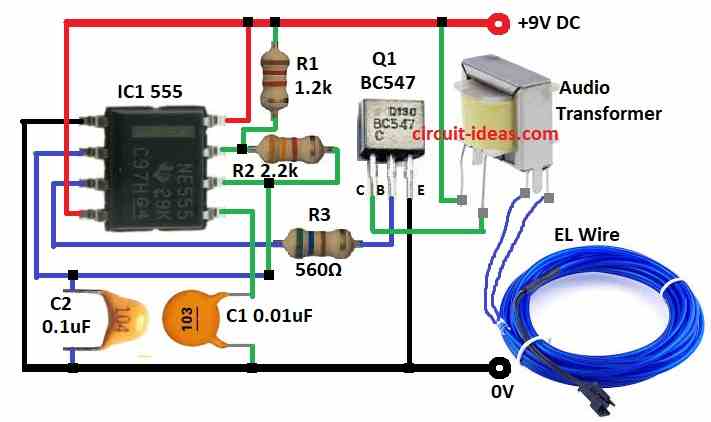A basic yet necessary electrical system for powering EL (Electroluminescent) wires is an EL wire inverter circuit.
EL wires are bright, flexible and thin wires that are frequently utilized in creative endeavors, costumes, signs and ornamental lighting.
They run on high voltage alternating current AC at certain frequencies usually between 100 and 200V AC at 1–5 kHz.
However, common DC power sources like batteries cannot directly power EL wires.
To transform low voltage direct current DC from a battery into high voltage alternating current AC appropriate for lighting the EL wire an inverter circuit is needed.
A transformer amplifies and steps up the high frequency signal produced by a 555 integrated circuit in Designing an EL Wire Power Supply Circuit
For novices, enthusiasts and anybody wishing to use EL wires in their projects this small and affordable circuit is a best choice.
This circuit provides a dependable way to power EL wires and is easy to construct because to its simple design and easily accessible parts.
Circuit Working:

Parts List:
| Component Type | Descriptions | Quantity |
|---|---|---|
| Resistors | 1.2k, 3.3k, 560Ω (1/4 watt) | 1 each |
| Capacitors | Ceramic 0.01μF, 0.1μF | 1 each |
| Semiconductors | IC 555 | 1 |
| NPN Transistor BC547 | 1 | |
| Transformer | Audio Transformer | 1 |
| Power Supply | 9V DC Battery | 1 |
Note: Resistor R2 is 3.3k mistakenly written as 2.2k
In this post the A 9V DC battery provides the input power.
When the 555 IC1 is set up in astable mode, it produces a continuous square wave at a predetermined frequency.
The values of R1, R2 and C2 define this frequency.
The BC547 Q1 transistors base receives the square wave output from the 555 IC1 through the resistor R3.
Resistors R1,R2 and R3 sets the frequency and stability of the oscillations.
Capacitors C1 and C2 ensure smooth oscillation and decouple any noise.
This signal is amplified by the transistor Q1, which permits enough current to power the transformer.
The transformers primary winding receives the amplified pulses.
To power the EL wire, the transformer raises the low DC voltage to a high AC voltage.
The EL wire is linked to the transformers secondary windings high AC voltage.
The phosphor coating within the EL wire is excited by this voltage which makes it shine.
Formulas and Calculations:
1: Frequency of Oscillation:
The resistors R1 and R2 as well as the capacitor C2 control the oscillation frequency of the 555 IC while it is in astable mode.
The frequency is calculated using the following formula:
f = 1.44 / ((R1 + 2 * R2) * C2)
where,
- R1 = 1.2k = 1200Ω
- R2 = 3.3k = 3300Ω
- C2 = 0.1μF = 10^-7 F
Substitute the values:
f = 1.44 / ((1200 + 2 * 3300) * 0.1 * 10^-6)
f = 1.44 / (1200 + 6600) * 0.1 * 10^-6
f = 1.44 / (7800 * 0.1 * 10^-6)
f = 1.44 / (7.8 * 10^-4)
f = 1846 Hz
Thus, the frequency of oscillation is approximately 1.86 kHz.
2: Duty Cycle
The duty cycle of the 555 IC output is:
Duty Cycle (%) = ((R1 + R2) / (R1 + 2 * R2)) * 100
Substitute the values:
Duty Cycle (%) = ((1200 + 3300) / (1200 + 2 * 3300)) * 100
Duty Cycle (%) = (4500 / 7800) * 100
Duty Cycle (%) = 57.69%
The duty cycle is approximately 57.69%.
How To Build:
For Designing an EL Wire Power Supply Circuit following are the below mentioned steps to follow:
- Gather all the components as mentioned in the above circuit diagram
- Connect pin 1 of IC1 555 to GRN.
- Connect pin 2 of IC1 555 to pin 6 through capacitor C2 and GND.
- Connect pin 3 of IC1 555 to base of transistor Q1 through resistor resistor R3.
- Connect pin 4 and pin 8 of IC1 555 to positive supply of 9V DC.
- Connect pin 5 of IC1 555 to GND through capacitor C1.
- Connect pin 6 of IC1 555 to pin 7 through resistor R2.
- Connect pin 7 of IC1 555 to positive of 9V DC through resistor R1.
- Connect collector of transistor Q1 to one primary wire of audio transformer and connect the other wire of audio transformer to positive supply of 9V DC.
- Connect the emitter of transistor Q1 to GND.
- Connect the secondary wire of Audio transformer to EL wires as shown in above circuit diagram.
Conclusion:
Designing EL wire inverter circuit offers a useful method for energizing EL wires in multiple uses.
Utilizing the adaptable 555 IC along with a basic transformer the circuit effectively transforms low voltage DC into the high frequency AC necessary for EL lighting.
Whether you are a student or an enthusiast, this project offers important knowledge about electronic circuit design and principles of AC generation.
Leave a Reply